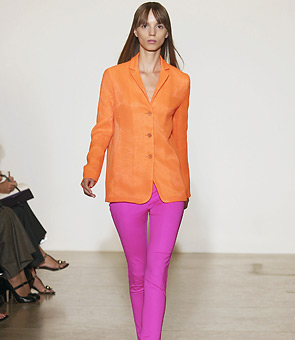
Jil Sander Spring/Summer 2008 collection
On the morning of his third Jil Sander show, the Belgian designer Raf Simons was nursing such a bad inner-ear infection that he could barely summon his balance. But even dizziness couldn't cloud Simons' extreme focus. With amazing ease and confidence (particularly for someone who could barely stand up) he took his fashion fans on a diversion into color, cut, proportion and volume. After laying back down the foundation of Sander's signature rigorous style for his first two seasons at the house, Simons is now poised to fly away in his own direction and he did just that—with a sure, cool hand. That Simons is able to address so many design issues in one fell swoop is the true sign of his talent. He can use color to tell a story about shifting proportions, in this case a skinny line comprised of stovepipe leggings and cropped jackets. Or he can take fabric innovation—a true Sander signature—and exploit it for a study in volume. One short tulle dress was constructed like a millefeuille and looked like a puffy gray raincloud. Neon orange coats had flyaway backs of organza in pale pink.
Color is a theme in so many ways for spring. Where Raf Simons pumped it up at Jil Sander, Tomas Maier made color an almost invisible — and extremely elegant — gesture at Bottega Venetta where he told a story of 1950s-style proportions and propriety with pale washed-out shades of putty, cement, marble and pink. It was Maier's most fluid and feminine collection yet for the luxury house that has been better known for it's woven leathergoods than for it's ready-to-wear.
As calming and cool-handed as Simons and Maier can be, Miuccia Prada can produce cacaphony and chaos with color. This evening she went on a kind of Art Nouveau acid trip that involved gingham, plaid pajama silks and hand-painted floral prints and organza appliques reminiscent of an Alphonse Mucha illustration. It was funky and wild and daring. And there were a hundred ideas, from the ceramic-heeled shoes to the hand-painted satin pocketbooks that models were filching backstage after the show.
The search for the new isn't a challenge that's only being played out on runways in Milan this season. Yesterday IT Holdings, the company that owns the Gianfranco Ferre brand, announced that Swedish designer Lars Nilsson will replace the late Ferre, who died in June at the age of 62. Nilsson is a good choice. He started out in the business as a couture assistant to Christian Lacroix and so he has the skills that are required to maintain Ferre's legacy of intricately crafted details, volumes and drama. He is also a wise choice because he will undoubtedly have an appreciation for the late designer's great cultural education and awareness. As generations of fashion dynasties pass the torch, the big challenge for journalists, buyers and head-hunters crawling all over this town is finding the new guard. Franca Sozzani, the editor of Italian Vogue has developed a contest to accomplish that very task. She urged me to go see two young Italian guys who design under the label 6267 last night. Although the shows yesterday were running an average of 90 minutes late due to traffic, the collection, inspired by Japanese kimono shapes, was worth the wait. Not only because they could be the next big thing, but because it's always refreshing to see young talent rise to Milan's commercial and creative challenge.